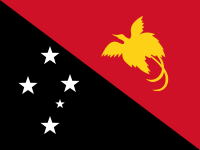
Photo from wikipedia
Background Tuberculosis is one of the deadliest disease caused by Mycobacterium tuberculosis . Its treatment still becomes a burden for many countries including Indonesia. Drug resistance is one of the… Click to show full abstract
Background Tuberculosis is one of the deadliest disease caused by Mycobacterium tuberculosis . Its treatment still becomes a burden for many countries including Indonesia. Drug resistance is one of the problems in TB treatment. However, a development in the molecular field through Whole-genome sequencing (WGS) can be used as a solution in detecting mutations associated with TB- drugs. This investigation intended to implement this data for supporting the scientific community in deeply understanding any TB epidemiology and evolution in Papua along with detecting any mutations in genes associated with TB-Drugs. Result A whole-genome sequencing was performed on the random samples from TB Referral Laboratory in Papua utilizing MiSeq 600 cycle Reagent Kit (V3). Furthermore, TBProfiler was used for genome analysis, RAST Server was employed for annotation, while Gview server was applied for BLAST genome mapping and a Microscope server was implemented for Regions of Genomic Plasticity (RGP). The largest genome of M. tuberculosis obtained was at the size of 4,396,040 bp with subsystems number at 309 and the number of coding sequences at 4326. One sample (TB751) contained one RGP. The drug resistance analysis revealed that several mutations associated with TB-drug resistance existed. In details, mutations of rpoB gene which were identified as S450L, D435Y, H445Y, L430P, and Q432K had caused the reduced effectiveness of rifampicin; while the mutases in katG (S315T), kasA (312S), inhA (I21V), and Rv1482c- fabG1 (C-15 T) genes had contributed to the resistance in isoniazid. In streptomycin, the resistance was triggered by the mutations in rpsL (K43R) and rrs (A514C, A514T) genes, and, in Amikacin, its resistance was led by mutations in rrs (A514C) gene. Additionally, in Ethambutol and Pyrazinamide, their reduced effectiveness was provoked by embB gene mutases (M306L, M306V, D1024N) and pncA (W119R). Conclusions The results from whole-genome sequencing of TB clinical sample in Papua, Indonesia could contribute to the surveillance of TB-drug resistance. In the drug resistance profile, there were 15 Multi Drugs Resistance (MDR) samples. However, Extensively Drug-resistant (XDR) samples have not been found, but samples were resistant to only Amikacin, a second-line drug.
Journal Title: BMC Genomics
Year Published: 2021
Link to full text (if available)
Share on Social Media: Sign Up to like & get
recommendations!